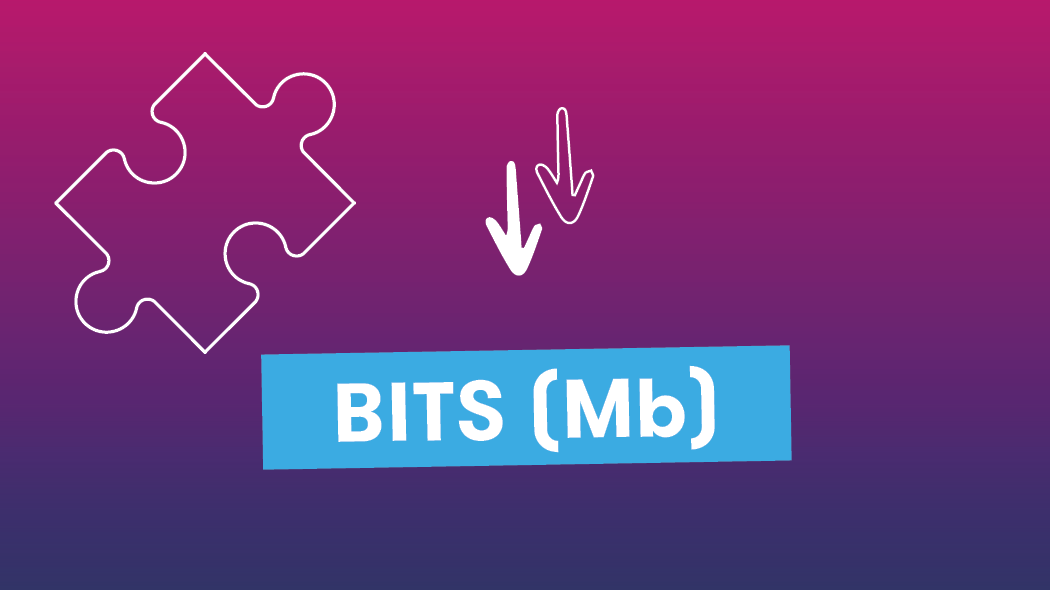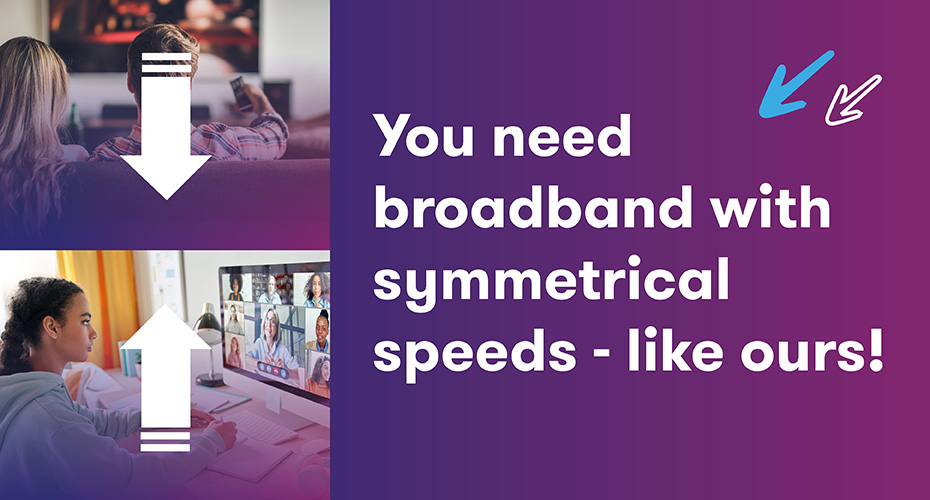Broadband speeds explained
 It's not just fast. It's Full Fibre.
It's not just fast. It's Full Fibre.

WELCOME TO YOUR GUIDE TO BROADBAND SPEEDS
Understanding broadband speeds can help you get the most out of your internet connection. Whether you’re streaming, gaming, working from home, or juggling multiple devices, here’s everything you need to know about getting the most from your Full Fibre broadband.
BITS & BYTES
First things first. You know how everyone talks about “megabits per second” (Mbps or Mb)? Well, here’s the kicker: a bit and a byte are not the same thing. They’re like cousins — related but definitely not interchangeable.

Bits: Tiny but mighty
The tiniest piece of digital info. A one or a zero. Think of it like a single puzzle piece.

Bytes: Bits in bulk
A group of 8 bits together, like a whole puzzle.
Let's sum it up
When you’re downloading a file or watching a movie, file sizes are measured in bytes. Internet speeds are measured in bits. So, when your ISP says you’re getting 100Mbps (or Mb), that’s megabits per second. Divide by 8, and you’re actually downloading at 12.5 megabytes per second. Confusing? A little. Important? Definitely!
UPLOAD VS. DOWNLOAD SPEEDS
Upload speeds are typically slower than downloads – but that doesn’t mean they don’t matter. A faster upload speed means your side of the conversation doesn’t lag behind. On the other hand, the faster your download speed, the smoother everything loads – no buffering!
Upload speeds
Uploads are all about sending data out from your device.
Think video calling, sending big email attachments, uploading photos to social media, backing up files to the cloud - or shouting into the digital void, if you’re into livestreaming.

Download speeds
Downloads are what most of us use the internet for, even if we don’t realise it. Streaming Netflix? Downloading. Browsing the news? Downloading. Scrolling through cat videos on TikTok at 2am? Still downloading.
The faster your download speed, the smoother everything loads - no buffering.

BANDWIDTH VS. LATENCY
aka speed vs responsiveness
Here’s where things get geeky but stay with us!
Bandwidth
Bandwidth is the max amount of data your connection can handle. It’s like the width of a highway — the wider it is, the more cars (data) can move at once.
Latency
Latency is the time it takes for data to travel. Think of it as your highway’s speed limit. Low latency = quick responses, crucial for gaming or video calls.
HOW TO RUN A SPEED TEST
Your broadband speed determines how fast you can download and upload data. If your internet feels slow, it could be due to a variety of factors. Testing your speed can help you diagnose the issue and optimise your connection.
Choose the right device Start with a modern device that supports high speeds. Older laptops, phones, or TVs may have speed caps, so double-check your device's specifications if results seem low.
Get connected For the most reliable results, use a CAT6 Ethernet Cable to connect your device directly into the router, close any unnecessary apps or programs running on the device, and disable any VPNs (especially on work devices), as they can interfere with speed test results.
Disconnect other devices To avoid other devices using bandwidth during the test, temporarily disconnect all other devices from the network and ensure no one else is online at the time.
Run the test multiple times Run your speed test at various times of the day to get an accurate understanding of your connection's performance during peak and off-peak hours.
More questions?

We get it - broadband jargon can be baffling. If you're still scratching your head over bits vs. bytes, or trying to work out how to optimise your broadband speeds, you're not alone. That’s why we’ve pulled together some of the most frequently asked questions about broadband speeds below.
-
Where can I run a speed test
First, it’s important to choose a reliable speed test tool. There’s several out there, but we advise using speedtest.net.
This tool measures your download speed, upload speed, and ping. Check out our handy guide.
Still seeing issues? Contact our support team for expert help.
-
How does Wi-Fi reach every room?
Your router pushes out radio waves, transmitting millions of bits of data per second, to your devices – like smart phones, computers or tablets.
It’s through these airwaves and technology that you are able to stream your favourite shows, battle your opponents online and work from home. But, there are some interfering elements that could make your connection slow and ruin your downtime, keep reading below to see what they are.
-
Why does my Wi-Fi feel slower in some rooms?
Walls, floors, and large objects can block signals. Have you considered using a Wi-Fi extender for better coverage? Find out more.
-
What household items are causing interference?
There’s a number of unexpected things that could be slowing down your Wi-Fi signal, as they have the ability to absorb or reflect wireless signals.
- Mirrors. They don’t just reflect light. Mirrors with even a thin metal backing can reflect Wi-Fi signals, causing them to bounce around and potentially create dead zones or electromagnetic interference.
- Bluetooth devices. Bluetooth devices, such as speakers, keyboards, and headphones, can operate on similar frequencies as Wi-Fi and might cause interference if they’re in close proximity. Our recommendation? If you’re not using it, switch it off!
- Fluorescent lights. Believe it or not, certain types of fluorescent lights can emit electromagnetic interference that can impact your connection, especially in the 2.4 GHz range. If possible, give alternative lights a go – like LED.
- Water. It’s bad news for your family goldfish. Water can absorb and weaken Wi-Fi signals. Large containers of water like fish tanks, or even a crowded room of people, can reduce performance.
- Microwaves. They’re a recipe for disaster! That’s right, microwaves also operate in the 2.4 GHz frequency range and can cause temporary interference when in use.
- Corded electronics. Some corded electronics, especially those with motors or transformers, can generate electromagnetic interference that might impact wi-fi performance.
- Walls and floors. As you would have guessed, thick walls made of concrete or brick, as well as floors with metal reinforcement, can significantly weaken Wi-Fi signals as they absorb or reflect the wireless signals.
-
How do I know I'm on the right frequency?
One travels further, and the other faster. Make sure your devices are on the right frequency for their needs. Our service transmits both 2.4GHz (further at lower speeds) and 5GHz (closer range but faster speeds).
Each device might have a preferred frequency, and you can check on the settings. We recommend putting your laptops, tablets and mobiles on 5GHz.
Sep 8, 2025
The basics of Wi-Fi
Jul 16, 2025











